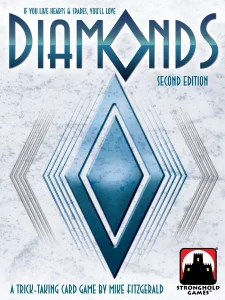Diamonds (2nd edition) Card Game Review

By MARK WILSON

Year Published: 2014
Players: 2-6
Playing Time: 20-30 Minutes
I have a mostly amiable relationship with trick-taking games, but occasionally tire of the many iterations available in the genre. On the one hand, there’s a lazy timelessness to something like Euchre that I’ll always enjoy. On the other hand, lots of trick taking games feel pretty similar and many go on for just a bit too long, given their simplicity and occasional randomness.
Diamonds (the 2nd edition of which, from 2014, is the most widely available) doesn’t manage to be different, necessarily. Sure, there are small twists to separate it from other games in the genre. But nothing’s being reinvented here.
Yet, I think Diamonds succeeds. And it’s because it maintains a breezy pace, manages to be clever in small bursts, and captures some of the lazy timelessness of Hearts, Spades, Euchre and others, while being different enough to entertain and engage.
The Premise
You’re dealt some cards, and the dealer decides whether to pass 1, 2, or 3 cards to the left. Dealer then leads a suit and the highest of that suit wins the trick. That winner leads the next trick. If you can play the lead suit, you must. So far, so same.
Each suit corresponds to an action related to the titular diamonds. We’ll come back to these.
If you can play an offsuit, you gain the action associated with that suit. If you win a trick, you gain the action of the suit that was led. If you win the most cards of any suit at the end of a round, you gain an action of that suit. And if you won no tricks in the round, you get two “diamond” actions.
These actions are the beating heart of the game. They are:
- Take a diamond from the supply and put it in your showroom
- Move a diamond from showroom to vault
- Steal a showroom diamond from another player
- Take a diamond and put it directly into your vault.
Vault diamonds are safe (and in a safe, har!). Showroom diamonds…aren’t. Vault diamonds are also hidden information, and unless you’re really good at memory games, you won’t remember everyone’s vault totals after long.
The Interplay of Actions
The trick-taking flows as smoothly as anything, but in the middle of tricks, offsuit plays will be yielding actions, giving another layer to each trick.
And as the game progresses, the table’s collective mentality will shift, as 1-2 players establish themselves with a lot of vaulted diamonds. They’ll then have to fend off the gleeful pilfering of the others.
Everything moves so quickly, that stealing doesn’t feel mean. It’s just business. Occasionally, two players will enter a mutually destructive grudge, and you’ll watch them steal diamonds back and forth in a hilarious tug of war. More often, though, everyone will feel the sting of these maneuvers just as often as anyone else.
And the hidden information means that by game’s end, you’re not entirely sure who you should be stealing from, or what the best cards will be to pass at the beginning of each round. It lends a healthy amount of paranoia to the proceedings that inevitably end with a few smirking sighs as people realize they should have stolen from Corey instead of Matt, even though Matt was being a jerk to you the entire game and seemed to clean up in one of the early rounds.
Trick-Taking Litmus Test
Some trick-taking games I tend to enjoy either grease the wheels of the game, so to speak, to the extent that there’s very little to be upset about. Or they throw grenades into the wheels to produce mechanical explosions of shrapnel that might take you down as collateral damage but will also be entertaining as you hurtle toward your demise. Diamonds is a tiny bit of the latter while retaining the former; it’s directly contentious in ways that will seem different than a lot of traditional cardplay, but all of the mechanics will feel familiar to anyone’s who’s ever played a classic card game.
Many beloved trick-taking games can also clock in at 45-60 minutes. I don’t care how novel the twist on trick-taking is; at that point the game is probably testing my patience unless it’s delivering something deeply satisfying. If Diamonds played in ~50 minutes instead of half that, I probably wouldn’t be writing as positive a review here.
So I’m happy to have found an iteration of trick-taking tropes in Diamonds that feels both familiar and fresh, and doesn’t overstay its welcome.
Diamonds isn’t a deep game, mind you. And despite the card passing, sometimes you’ll get a bad draw and it will kill your round, which isn’t insurmountable but is a definite disadvantage. The game is over quickly enough, though, and this is rare enough, that it’s no more a concern than with any game involving dice rolls or card draws.
So if you need a trick-taking option that’s slightly more modern-feeling than the classics you grew up with, but retains those classics’ flavor and won’t bog anyone down with obtuse rules, Diamonds may fit the bill.
…
For more content, or just to chat, find me on Twitter @BTDungeons, or check out my other reviews and game musings!
Share
Recent Posts
Categories
- All (347)
- Announcements (4)
- Board Games (201)
- DMing (28)
- Game Design (16)
- Playing TTRPGs (21)
- Reviews (188)
- RPGs (141)
- Session Reports (90)
- Why Games Matter (9)